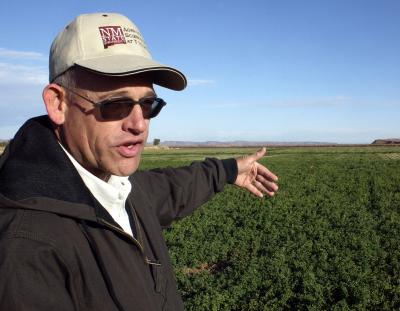Teff could be a solution for drought-stricken forage

As drought continues to challenge New Mexico's agriculture, New Mexico State University's Agricultural Experiment Station's research indicates teff forage to be a premium alternative crop that is heat resistant and requires less water to thrive.
Teff forage was introduced to New Mexico from Ethiopia about 10 years ago. Leonard Lauriault, superintendent at the NMSU Agricultural Science Center at Tucumcari, assessed the benefits of this hay crop at the Tucumcari and Los Lunas science centers.
Although in Ethiopia and parts of the U.S. the grain teff produces, which is comparable to wheat, is used for human consumption, Lauriault's research focused on teff's value as a forage crop.
The grain is strictly used for human consumption and the forage for hay production. Lauriault said that teff is not suitable for grazing because it has a weak root system in contrast to alfalfa.
"There's considerable amount of variability between our study and what has been previously published," Lauriault said. "We found that the teff could yield about the same as alfalfa in the second half of the growing season with half the water."
"What producers can do is have the alfalfa and have another field of teff, since alfalfa does not need a lot of water in the spring," Lauriault said. "Stop irrigating the alfalfa after mid-June and water teff for the rest of the growing season. With about half the water you would use for alfalfa, you get the same yields."
Teff should not be planted too early in the spring because it is not tolerant of cold temperatures and has the time to thrive without the interference of other weeds.
Lauriault added that teff is a top quality feed, mainly used for horses. His 2007-2008 research using irrigation water demonstrated that planting in mid-June or early July, which is considered late planting, "may have shortened the time between planting and the first harvest and possibly saved irrigation water."
The study also showed that teff could be used for dairy feed, but it is a better source of feed for horses, especially those that are diabetic or have metabolic disorders.
Mark Marsalis, Extension forage specialist at the NMSU Agricultural Science Center at Los Lunas, added that "teff grows well throughout much of New Mexico, and one of its primary qualities is that it is a drought-tolerant crop, palatable for horses."
He said that teff seems to be preferred by horses because of its fine-stemmed nature and high quality, which is similar to timothy hay.
"Teff doesn't have any of the toxicity concerns that other emergency and rotational forages such as sorghum sudangrass and millets have," Marsalis said. "It is much safer to feed to both horses and cattle, and broadens the grower's market options."
Teff also benefits from nitrogen and Lauriault recommends about 90 to 100 pounds per acre of nitrogen annually, which is less than what is consumed by sorghum and millet forages. This equates to about 30-50 pounds per acre, per cutting.
"The first nitrogen application, about 60 pounds per acre, is best applied after it is planted," Lauriault said. "After the second cutting, if there is time for a third cutting, about 30 more pounds per acre of nitrogen can be applied."
Alternating alfalfa and teff during different growing seasons helps with the irrigation water scarcity that is notable after the first growing season.
The economic impact can be significant because teff needs less water and fits into the alfalfa rotation system. Leftover nitrogen from the previous alfalfa crop can be used, saving on fertilizer costs. Also, the same tools and equipment used to plant, harvest and manage alfalfa can be used for teff.
"It is a great crop for hay growers because it is easy to grow, produces a lot of forage and may bring an excellent price because of the high demand in the horse market," Marsalis said.
"It is another opportunity for alfalfa growers who are particularly interested in the horse market to grow something when they are rotating their alfalfa and renovating that field to get ready to plant again," Lauriault said.


